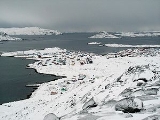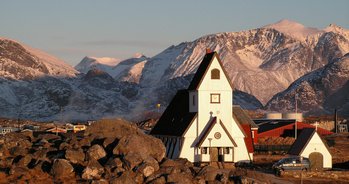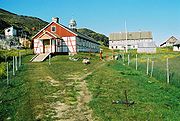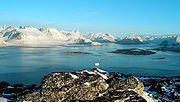
Nanortalik
Encyclopedia
Nanortalik is a town in the Kujalleq
municipality in southern Greenland
. With 1,448 inhabitants in 2010, it is the tenth-largest town in the country. The name Nanortalik means "place of polar bears
" or "place where the polar bears go" (from ).
and by the Norse
. Nanortalik was founded in 1770. In 1797, a permanent trading depot was set up in Nanortalik by traders from Julianehåb. Due to poor harbour facilities, in 1830 the town was moved three kilometers northward, where it remains today. Of the old town only the scattered ruins of Sissarissoq remain.
, roughly 100 km north of Uummannarsuaq
, the southern tip of Greenland.
The surrounding district extends from the island of Qeqertarsuaq near Alluitsup Paa down to Cape Farewell and the 60 km long Lindenow Fjord on the east coast. The district covers a total of 15,000 sq. kilometers (5,800 sq. miles).
Nearby settlements are Narsarmijit
(Frederiksdal), Alluitsup Paa
(Sydprøven), Tasiusaq
, Aappilattoq
, Ammassivik
as well as the following settlements with no more than 20 inhabitants each: Saputit, Nalasut, Nuugaarsuk, Akuliaruseq, Qallimiut, Qorlortorsuaq, Alluitsoq, and the weather station Ikerasassuaq.
 Nanortalik Island is located near the mouth of the 70 km long Tasermiut Fjord. The island measures about 10 km across and features two minor mountains: Quaqqarsuasik ('Storfjeldet' in Danish) and Quassik ('Ravnefjeldet' in Danish or Raven Mountain in English). Quaqqarsuasik is 559 m and Quassik 308 m.
Nanortalik Island is located near the mouth of the 70 km long Tasermiut Fjord. The island measures about 10 km across and features two minor mountains: Quaqqarsuasik ('Storfjeldet' in Danish) and Quassik ('Ravnefjeldet' in Danish or Raven Mountain in English). Quaqqarsuasik is 559 m and Quassik 308 m.
 Crab fishing, hunting for hooded seals, and fishing from small boats are the main sources of income for the area's inhabitants. Over the past few years, a goldmine in Kirkespir Valley (Kirkespirdalen), 30 km north Nanortalik has proven highly successful, and this is likely to change the structure of the town's economy.
Crab fishing, hunting for hooded seals, and fishing from small boats are the main sources of income for the area's inhabitants. Over the past few years, a goldmine in Kirkespir Valley (Kirkespirdalen), 30 km north Nanortalik has proven highly successful, and this is likely to change the structure of the town's economy.
During the spring, many Greenlanders hunt hooded seals among the outer islands, where the pack ice
drifts up from the east coast on its way north. The age-old culture of the Inuit lives on in this annual hunting tradition.
Nanortalik has little productive trade. There are no factories and no large-scale fishing activities as sea ice prevents fishing for several months a year. Small-scale fishing, crab fishing, seal and seabird hunting and tourism provide most of the locally produced revenue. Recently, a gold mine opened in Kirkespirsdalen some 30 km north of Nanortalik town. Decades ago, a now abandoned graphite
mine operated some 20 km from the town. The mine was abandoned in 1925.
 While Greenland is almost completely without trees, the Qinngua valley some 40 km from Nanortalik town has the only forest in Greenland (at 60°17′38"N 44°29′45"W). Here, Willow (Salix glauca) and Birch (Betula pubescens) trees grow up to a height of several meters. Most other places, trees grow up to a maximum of about half a meter height. The valley also has some 300 species of other plants, in addition to many lichen
While Greenland is almost completely without trees, the Qinngua valley some 40 km from Nanortalik town has the only forest in Greenland (at 60°17′38"N 44°29′45"W). Here, Willow (Salix glauca) and Birch (Betula pubescens) trees grow up to a height of several meters. Most other places, trees grow up to a maximum of about half a meter height. The valley also has some 300 species of other plants, in addition to many lichen
s.
The wildlife of the Nanortalik island is rather sparse due to native hunters. As a result, raven
s, seagulls and snow bunting
s are some of the very few abundant larger bird species, and no mammal larger than a mouse is likely to be seen on the island. However, the surrounding areas count numerous species.
In addition to seals, the pack ice also brings polar bears from the east coast – hence the name Nanortalik. Every year a number of bears are sighted in the area, but they rarely present a threat to people. During the spring and late summer, there are many whales in the waters around the town, with minke whales being the most common visitors.
Birdlife includes raven
, ptarmigan, Glaucous Gull
, Iceland Gull
, snow bunting
, guillemot
, eider
, king eider
, gyrfalcon
, white-tailed eagle
, redpoll
, red-necked phalarope
, various sandpipers, red-breasted merganser
, red-throated diver
, great northern diver
, cormorant
, long-tailed duck
, puffin
, northern wheatear
, little auk
, various duck
species, and more rarely, snowy owl
s.
Despite the allusion to polar bear
s in its name, they are rare sights in Nanortalik, but occasionally come drifting in on sea ice
from East Greenland in the months of January to June.
, followed by Hooded Seal
and harp seal
.
From August until October minke whale
s are common near the opening of the Tasermiut Fjord. Occasionally, humpback whale
s and orca
s are spotted.
operates year-round as a helicopter hub of Air Greenland
, linking Nanortalik with all settlements in the region, and with Narsarsuaq Airport, and hence indirectly with the rest of Greenland, and with Europe.
Kujalleq
Kujalleq is a new municipality in the southern tip of Greenland, operational from 1 January 2009. With 7,589 inhabitants as of January 2010, it is the least-populated municipality in Greenland. The administrative center of the municipality is in Qaqortoq...
municipality in southern Greenland
Greenland
Greenland is an autonomous country within the Kingdom of Denmark, located between the Arctic and Atlantic Oceans, east of the Canadian Arctic Archipelago. Though physiographically a part of the continent of North America, Greenland has been politically and culturally associated with Europe for...
. With 1,448 inhabitants in 2010, it is the tenth-largest town in the country. The name Nanortalik means "place of polar bears
Polar Bear
The polar bear is a bear native largely within the Arctic Circle encompassing the Arctic Ocean, its surrounding seas and surrounding land masses. It is the world's largest land carnivore and also the largest bear, together with the omnivorous Kodiak Bear, which is approximately the same size...
" or "place where the polar bears go" (from ).
History
Because of its location, this area was one of the first parts of Greenland settled, both by InuitInuit
The Inuit are a group of culturally similar indigenous peoples inhabiting the Arctic regions of Canada , Denmark , Russia and the United States . Inuit means “the people” in the Inuktitut language...
and by the Norse
Norsemen
Norsemen is used to refer to the group of people as a whole who spoke what is now called the Old Norse language belonging to the North Germanic branch of Indo-European languages, especially Norwegian, Icelandic, Faroese, Swedish and Danish in their earlier forms.The meaning of Norseman was "people...
. Nanortalik was founded in 1770. In 1797, a permanent trading depot was set up in Nanortalik by traders from Julianehåb. Due to poor harbour facilities, in 1830 the town was moved three kilometers northward, where it remains today. Of the old town only the scattered ruins of Sissarissoq remain.
Geography
Nanortalik is located on a small island (also called Nanortalik) on the shores of Labrador SeaLabrador Sea
The Labrador Sea is an arm of the North Atlantic Ocean between the Labrador Peninsula and Greenland. The sea is flanked by continental shelves to the southwest, northwest, and northeast. It connects to the north with Baffin Bay through the Davis Strait...
, roughly 100 km north of Uummannarsuaq
Cape Farewell, Greenland
Cape Farewell , is a headland on the southern shore of Egger Island, Greenland. Located at it is the southernmost extent of Greenland, projecting out into the North Atlantic Ocean and the Labrador Sea on the same latitude as Stockholm and the Scottish Shetland Islands. Egger and the associated...
, the southern tip of Greenland.
The surrounding district extends from the island of Qeqertarsuaq near Alluitsup Paa down to Cape Farewell and the 60 km long Lindenow Fjord on the east coast. The district covers a total of 15,000 sq. kilometers (5,800 sq. miles).
Nearby settlements are Narsarmijit
Narsarmijit
Narsarmijit is a settlement in the Kujalleq municipality in southern Greenland. Its population is 97 as of 2010...
(Frederiksdal), Alluitsup Paa
Alluitsup Paa
Alluitsup Paa is a village in the Kujalleq municipality in southern Greenland. Founded in 1830, Alluitsup Paa had 303 residents in 2010....
(Sydprøven), Tasiusaq
Tasiusaq, Kujalleq
Tasiusaq is a settlement in the Kujalleq municipality in southern Greenland. It is located at the Tasermiut Fjord , east of Nanortalik. Its population is 90 as of 2010...
, Aappilattoq
Aappilattoq, Kujalleq
Aappilattoq is a village in the Kujalleq municipality in southern Greenland. The name means "sea anemone" in the Greenlandic language...
, Ammassivik
Ammassivik
Ammassivik is a settlement in the Kujalleq municipality in southern Greenland. The name means "plain" in the Greenlandic language. Its population is 74 as of 2010....
as well as the following settlements with no more than 20 inhabitants each: Saputit, Nalasut, Nuugaarsuk, Akuliaruseq, Qallimiut, Qorlortorsuaq, Alluitsoq, and the weather station Ikerasassuaq.
Nanortalik Island

Mountaineering
Nanortalik is most well known for its towering mountain peaks and vertical walls in Tasermiut Fjord. Names like Ketil Mountain (1500 m) and Ulamertorsuaq are familiar to mountain climbers from around the world. The mountains in the region can easily be compared with the toughest routes in the Alps, and challenging ascents should only be attempted by experienced climbers.Economy

During the spring, many Greenlanders hunt hooded seals among the outer islands, where the pack ice
Drift ice
Drift ice is ice that floats on the surface of the water in cold regions, as opposed to fast ice, which is attached to a shore. Usually drift ice is carried along by winds and sea currents, hence its name, "drift ice"....
drifts up from the east coast on its way north. The age-old culture of the Inuit lives on in this annual hunting tradition.
Nanortalik has little productive trade. There are no factories and no large-scale fishing activities as sea ice prevents fishing for several months a year. Small-scale fishing, crab fishing, seal and seabird hunting and tourism provide most of the locally produced revenue. Recently, a gold mine opened in Kirkespirsdalen some 30 km north of Nanortalik town. Decades ago, a now abandoned graphite
Graphite
The mineral graphite is one of the allotropes of carbon. It was named by Abraham Gottlob Werner in 1789 from the Ancient Greek γράφω , "to draw/write", for its use in pencils, where it is commonly called lead . Unlike diamond , graphite is an electrical conductor, a semimetal...
mine operated some 20 km from the town. The mine was abandoned in 1925.
Flora and fauna

Lichen
Lichens are composite organisms consisting of a symbiotic organism composed of a fungus with a photosynthetic partner , usually either a green alga or cyanobacterium...
s.
The wildlife of the Nanortalik island is rather sparse due to native hunters. As a result, raven
Raven
Raven is the common name given to several larger-bodied members of the genus Corvus—but in Europe and North America the Common Raven is normally implied...
s, seagulls and snow bunting
Snow Bunting
The Snow Bunting , sometimes colloquially called a snowflake, is a passerine bird in the longspur family Calcariidae. It is an arctic specialist, with a circumpolar Arctic breeding range throughout the northern hemisphere...
s are some of the very few abundant larger bird species, and no mammal larger than a mouse is likely to be seen on the island. However, the surrounding areas count numerous species.
In addition to seals, the pack ice also brings polar bears from the east coast – hence the name Nanortalik. Every year a number of bears are sighted in the area, but they rarely present a threat to people. During the spring and late summer, there are many whales in the waters around the town, with minke whales being the most common visitors.
Birdlife includes raven
Raven
Raven is the common name given to several larger-bodied members of the genus Corvus—but in Europe and North America the Common Raven is normally implied...
, ptarmigan, Glaucous Gull
Glaucous Gull
The Glaucous Gull is a large gull which breeds in the Arctic regions of the northern hemisphere and the Atlantic coasts of Europe. It is migratory, wintering from in the North Atlantic and North Pacific oceans as far south as the British Isles and northernmost states of the USA, also on the Great...
, Iceland Gull
Iceland Gull
The Iceland Gull, Larus glaucoides, is a large gull which breeds in the Arctic regions of Canada and Greenland, but not Iceland, where it is only seen in the winter. It is migratory, wintering from in the North Atlantic as far south as the British Isles and northernmost states of the eastern USA,...
, snow bunting
Snow Bunting
The Snow Bunting , sometimes colloquially called a snowflake, is a passerine bird in the longspur family Calcariidae. It is an arctic specialist, with a circumpolar Arctic breeding range throughout the northern hemisphere...
, guillemot
Guillemot
Guillemots is the common name for several species of seabird in the auk family . In British use, the term comprises two genera: Uria and Cepphus. In North America the Uria species are called "murres" and only the Cepphus species are called "guillemots"...
, eider
Eider
Eiders are large seaducks in the genus Somateria. Steller's Eider, despite its name, is in a different genus.The three extant species all breed in the cooler latitudes of the Northern hemisphere....
, king eider
King Eider
The King Eider is a large sea duck that breeds along northern hemisphere Arctic coasts of northeast Europe, North America and Asia. The birds spend most of the year in coastal marine ecosystems at high latitudes, and migrate to Arctic tundra to breed in June and July...
, gyrfalcon
Gyrfalcon
The Gyrfalcon — Falco rusticolus — is the largest of the falcon species. The Gyrfalcon breeds on Arctic coasts and the islands of North America, Europe, and Asia. It is mainly resident there also, but some Gyrfalcons disperse more widely after the breeding season, or in winter.Individual vagrancy...
, white-tailed eagle
White-tailed Eagle
The White-tailed Eagle , also known as the Sea Eagle, Erne , or White-tailed Sea-eagle, is a large bird of prey in the family Accipitridae which includes other raptors such as hawks, kites, and harriers...
, redpoll
Redpoll
The Redpolls are a group of small passerine birds in the finch family Fringillidae which have characteristic red markings on their heads. They were formerly placed into the genus Acanthis together with the linnets and the twite, but their closest relatives are actually the crossbills, that are...
, red-necked phalarope
Red-necked Phalarope
The Red-necked Phalarope, Phalaropus lobatus, is a small wader. This phalarope breeds in the Arctic regions of North America and Eurasia. It is migratory, and, unusually for a wader, winters at sea on tropical oceans....
, various sandpipers, red-breasted merganser
Red-breasted Merganser
The Red-breasted Merganser is a diving duck.-Taxonomy:The Red-breasted Merganser was one of the many species originally described by Linnaeus in his 18th-century work, Systema Naturae.-Description:...
, red-throated diver
Red-throated Diver
The Red-throated Loon or Red-throated Diver is a migratory aquatic bird found in the northern hemisphere. It breeds primarily in Arctic regions, and winters in northern coastal waters. It is the most widely distributed member of the loon or diver family. Ranging from in length, the Red-throated...
, great northern diver
Great Northern Diver
The Great Northern Loon, Great Northern Diver, or Common Loon , is a large member of the loon, or diver, family of birds...
, cormorant
Cormorant
The bird family Phalacrocoracidae is represented by some 40 species of cormorants and shags. Several different classifications of the family have been proposed recently, and the number of genera is disputed.- Names :...
, long-tailed duck
Long-tailed Duck
The Long-tailed Duck or Oldsquaw is a medium-sized sea duck. It is the only living member of its genus, Clangula; this was formerly used for the goldeneyes, with the Long-tailed Duck being placed in Harelda...
, puffin
Puffin
Puffins are any of three small species of auk in the bird genus Fratercula with a brightly coloured beak during the breeding season. These are pelagic seabirds that feed primarily by diving in the water. They breed in large colonies on coastal cliffs or offshore islands, nesting in crevices among...
, northern wheatear
Northern Wheatear
The Northern Wheatear or Wheatear is a small passerine bird that was formerly classed as a member of the thrush family Turdidae, but is now more generally considered to be an Old World flycatcher, Muscicapidae...
, little auk
Little Auk
The Little Auk, or Dovekie , is a small auk, the only member of the genus Alle. It breeds on islands in the high Arctic. There are two subspecies: A. a. alle breeds in Greenland, Iceland, Novaya Zemlya and Spitsbergen, and A. a...
, various duck
Duck
Duck is the common name for a large number of species in the Anatidae family of birds, which also includes swans and geese. The ducks are divided among several subfamilies in the Anatidae family; they do not represent a monophyletic group but a form taxon, since swans and geese are not considered...
species, and more rarely, snowy owl
Snowy Owl
The Snowy Owl is a large owl of the typical owl family Strigidae. The Snowy Owl was first classified in 1758 by Carolus Linnaeus, the Swedish naturalist who developed binomial nomenclature to classify and organize plants and animals. The bird is also known in North America as the Arctic Owl, Great...
s.
Despite the allusion to polar bear
Polar Bear
The polar bear is a bear native largely within the Arctic Circle encompassing the Arctic Ocean, its surrounding seas and surrounding land masses. It is the world's largest land carnivore and also the largest bear, together with the omnivorous Kodiak Bear, which is approximately the same size...
s in its name, they are rare sights in Nanortalik, but occasionally come drifting in on sea ice
Sea ice
Sea ice is largely formed from seawater that freezes. Because the oceans consist of saltwater, this occurs below the freezing point of pure water, at about -1.8 °C ....
from East Greenland in the months of January to June.
Marine mammals
Seals are common in surrounding fjords. The most common seal is ringed sealRinged Seal
The ringed seal , also known as the jar seal and as netsik or nattiq by the Inuit, is an earless seal inhabiting the Arctic and sub-Arctic regions...
, followed by Hooded Seal
Hooded Seal
The hooded seal is an arctic pinniped found only in the central and western North Atlantic ranging from Svalbard in the east to the Gulf of St...
and harp seal
Harp Seal
The harp seal or saddleback seal is a species of earless seal native to the northernmost Atlantic Ocean and adjacent parts of the Arctic Ocean. It now belongs to the monotypic genus Pagophilus. Its scientific name, Pagophilus groenlandicus, means "ice-lover from Greenland", and its synonym, Phoca...
.
From August until October minke whale
Minke Whale
Minke whale , or lesser rorqual, is a name given to two species of marine mammal belonging to a clade within the suborder of baleen whales. The minke whale was given its official designation by Lacepède in 1804, who described a dwarf form of Balænoptera acuto-rostrata...
s are common near the opening of the Tasermiut Fjord. Occasionally, humpback whale
Humpback Whale
The humpback whale is a species of baleen whale. One of the larger rorqual species, adults range in length from and weigh approximately . The humpback has a distinctive body shape, with unusually long pectoral fins and a knobbly head. It is an acrobatic animal, often breaching and slapping the...
s and orca
Orca
The killer whale , commonly referred to as the orca, and less commonly as the blackfish, is a toothed whale belonging to the oceanic dolphin family. Killer whales are found in all oceans, from the frigid Arctic and Antarctic regions to tropical seas...
s are spotted.
Population
With 1,448 inhabitants as of 2010, Nanortalik is the third-largest town in the Kujalleq municipality. The population has been decreasing over the last several years. Most towns and settlements in southern Greenland exhibit negative growth patterns over the last two decades, with many settlements rapidly depopulating.Transport
Nanortalik HeliportNanortalik Heliport
Nanortalik Heliport is a heliport in the eastern part of Nanortalik, a town in the Kujalleq municipality in southern Greenland.- Airlines and destinations :...
operates year-round as a helicopter hub of Air Greenland
Air Greenland
Air Greenland A/S is the flag carrier airline of Greenland, jointly owned by the government of Greenland, the SAS Group, and the government of Denmark...
, linking Nanortalik with all settlements in the region, and with Narsarsuaq Airport, and hence indirectly with the rest of Greenland, and with Europe.
Points of interest
- Angissq LORAN-C transmitterAngissq LORAN-C transmitterAngissq LORAN-C transmitter was a LORAN-C transmitter at Nanortalik-Angissq, Greenland of GRI 7930, 59°59'18"N, 45°10'24" W . Angissq LORAN-C transmitter had a transmission power of 1000 kilowatts....
- Cape Farewell, GreenlandCape Farewell, GreenlandCape Farewell , is a headland on the southern shore of Egger Island, Greenland. Located at it is the southernmost extent of Greenland, projecting out into the North Atlantic Ocean and the Labrador Sea on the same latitude as Stockholm and the Scottish Shetland Islands. Egger and the associated...
, the southermost point of Greenland

